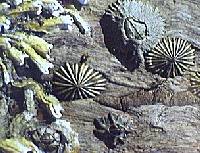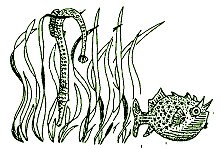Theme: Communities Celebrating the Sea
Seaweek '88 coordinators: Julie Swartz, Pauline Halpin, Greg McGarvie
Extending the theme - classroom activities
These educational activities are
adapted from the Marine
Life Resources Kit of Seaweek'89
by the Marine Studies Centre, Queenscliff What am I?
Aim - to describe and recognise some marine life.
Activity
| Read the following clues and ask the students to identify the animal described. |
| |
|
|
| |
"When I am not feeding people think I am merely a blob. Unlike you, I have no skeleton to support me and I can only move slowly. I glide across my rocky home on my soft 'suction-cup' bottom. When the tide comes in, I open out like a flower and wave my tentacles around to catch tiny animals that I cannot see.
|
 |
When they touch me, I poison them with stinging tentacles and put them into my mouth. It takes me all night to digest my dinner and I have to spit out the hard bits. I think I am a beautiful creature and I rarely get eaten by others because they are afraid of my tentacles".
- Ask the students to write their own 'What am I' clues using posters and books as stimulus.
- Present all the clues to the whole class.
Living on the Edge
Aim - to consider the problems facing animals living on the edge between land and sea.
 Activity Activity
- Discuss the beach and rocky shore as habitats. They are neither land nor sea, yet both. Refer to the movements of tides in and out twice a day.
- List some of the wildlife of these environments.
- Discuss the problems faced by those living there eg wave action, tidal movements, drying out, heating up, sunburn, salinity changes, exposure to predators, lack of food etc.
- Identify the adaptations possessed by the plants and animals that make life in these environments possible eg behaviour, feeding patterns, body shapes etc.
|
|
What's for Dinner?
Aim
- to understand why, how and on what some animals feed.
 Activity Activity
- Ask the students why they eat (for energy) and what they need energy for (moving, breathing etc).
- Look at posters or in books and discuss how a marine animal might feed. You will need to consider:
- their habitats (crab - rocky reef, anemone - rock pool and cowfish - seagrass bed) and
- their mobility (crab - slow crawler, anemone - almost stationary and cowfish - quick swimmer).
- Discuss what they could and could not eat:
- Crabs scavenge on dead matter,
- anemone traps small fish and crustaceans and
- cowfish picks up small crabs and shrimps).
- Ask the students to mime the moving and feeding actions of a marine animal. Other students should guess what they are.
Sea Water Science
Aim
- to investigate some properties of sea water.
Activity
- Compare the taste of sea water and fresh water.
- Demonstrate dissolving salt in water.
- Evaporate sea water and fresh water in shallow jars (sun or heat source). Students should discover salt crystals from sea water.
- Look through a glass of water to see that it is transparent, then discuss why the ocean is blue.
- Leave a jar of water in a warm place until small oxygen bubbles form at the surface. Students should conclude that oxygen also is dissolved in water.
- Add a few drops of food dye to fresh water in a jar. Pour in sea water, it should sink below the coloured water because it is more dense (heavier), due to the dissolved minerals it contains.
- Test a variety of objects for buoyancy in sea and fresh water.
 |
Life in the seagrass
A Pipefish and Cowfish.
- What are their needs?
- What are their adaptations?
- How do they survive?
|
|
|